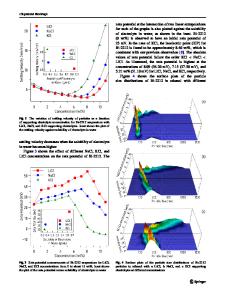Bi 2 Sr 2 CaCu 2 O 8+x films prepared by fluorinated precursors in dry ambient
- PDF / 973,981 Bytes
- 6 Pages / 576 x 792 pts Page_size
- 45 Downloads / 334 Views
Bi 2 Sr 2 CaCu 2 0 8+;( : films were prepared by mixing 2-ethylhexanoate precursors with heptafluorobutyric acid and annealing at 820 °C in dry ambient. The films underwent substantial mass transport and exhibited abnormal grain growth, indicating that some liquid phases might be involved in the process. It was found that the high atomic mobilities during annealing significantly improved in-plane orientations and consequently increased critical current densities. I. INTRODUCTION Metalorganic deposition (MOD) is a method amenable to the preparation of superconducting thin films. Advantages specific to the process include process simplicity and accurate compositional control.1"5 However, films prepared by MOD generally show low critical current densities and high field dependence.6'7 The poor transport properties are attributed to high concentration of residual carbon from the decomposition of carboxylates and mutual misalignment of highly anisotropic grains in the films. Metal trifluoroacetate precursors have been used to prepare superconducting thin films of YBa^usOy-^ on ZrO 2 and SrTiO3.8~10 In those cases, metal fluorides are formed by decomposition of the precursor and then converted to oxides by reacting with water vapor. The resulting films were reported to have sharp resistive transitions with Tc above 90 K and high critical current densities. The improvements were interpreted as being due to complete elimination of stable barium carbonate. Recently, Hung et al. reported that carbon contamination is one of the main causes for poor transport properties of YBa^usOy-^, but it has a minor effect on Bi2Sr2CaCu208+JC (2212) as the films contain low concentration of carbon and exhibit clean grain boundaries.11 The attainable low critical current density in 2212 is ascribed to misalignment of in-plane orientations. In this paper we report a novel process that involves mixing a regular 2212 precursor with heptafluorobutyric acid (C3F7COOH) and annealing the fluorinated films in dry ambient. This process can dramatically enhance atomic diffusion, thus improving structure and transport properties of the films. We also compare the results to those obtained from the regular 2-ethylhexanoate precursor.
cium 2-ethylhexanoate, and copper 2-ethylhexanoate.4 The precursor had a concentration of about 1.63 X 10~4 mol/g and was mixed with heptafluorobutyric acid at a ratio of 1:0.17 by weight. Both regular and fluorinated precursors were spin coated onto (OOl)MgO or (001)SrTiO3 at 4000 rpm for 20 s. The precursor was converted to an inorganic film after heat treatment on a hot plate at 450 °C. The layer formation process was repeated until a final thickness of 1-1.5 /xm was achieved. Films were then thermally processed in air at temperatures of 800-865 °C to form the desired superconducting phases. In some cases multiple coatings of the 2-ethylhexanoate precursor were employed. The precursor was diluted with 2-ethylhexanoic acid, so that the film coated at 4000 rpm had a thickness of 60 nm after processing on a hot plate. The
Data Loading...











